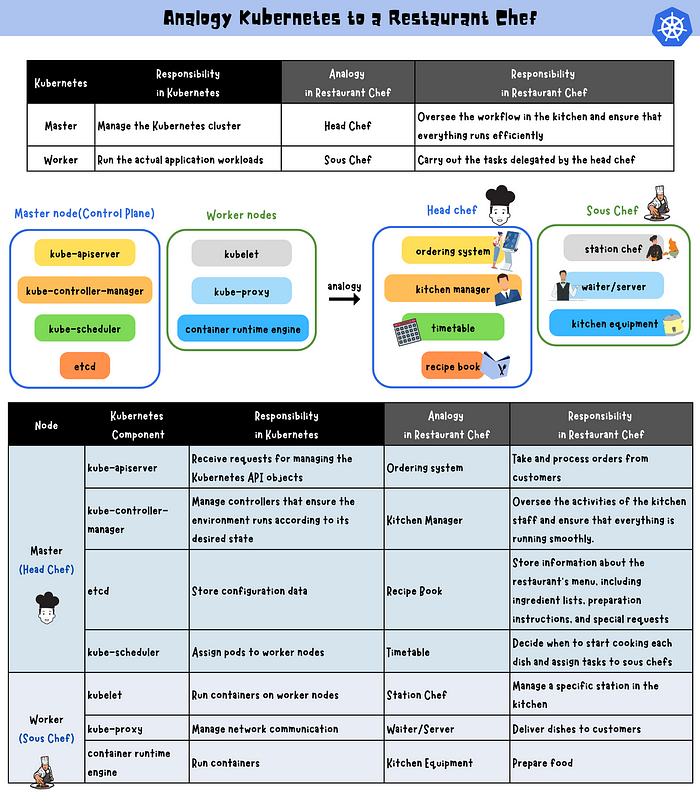Kubernetes: Understanding Kubernetes Architecture through a Restaurant Chef’s Analogy
In the analogy of Kubernetes to a restaurant chef, the master node is like the head chef who manages the ordering system (kube-apiserver), the kitchen manager (kube-controller-manager), the recipe book (etcd), and the timetable (kube-scheduler). The worker node is like a sous chef who manages the station chef (kubelet), the waiter or server (kube-proxy), and the kitchen equipment (container runtime engine). This analogy can help make the complex system of Kubernetes easier to understand.

Content of Tables
· Kubernetes Architecture Overview
· Restaurant Chef's Analogy
· Master Node(Head Chef)
∘ kube-apiserver(ordering system)
∘ kube-controller-manager(kitchen manager)
∘ kube-scheduler(timetable)
∘ etcd (recipe book)
· Worker Node(Sous Chef)
∘ kubelet(station chef)
∘ kube-proxy(waiter/server)
∘ container runtime engine(kitchen equipment)Kubernetes Architecture Overview

Restaurant Chef’s Analogy
Kubernetes is like a restaurant chef who manages a busy kitchen. The master node acts as the head chef, overseeing the entire kitchen’s workflow, while the worker nodes represent individual kitchen stations where different dishes are prepared. Kubernetes manages container images, deployments, and scaling, similar to how a chef manages ingredients, recipes, and timing.
Master Node(Head Chef)
The master node can be compared to a head chef in a restaurant, as it is responsible for managing and coordinating all the operations in the cluster(kitchen). It does this by running several components such as kube-apiserver, etcd, kube-scheduler, and kube-controller-manager. Together, these components ensure that the cluster is functioning correctly and efficiently, just as a head chef manages and coordinates all the operations in a restaurant to ensure the smooth functioning of the kitchen.

kube-apiserver(ordering system)
kube-apiserver provides a REST API for users and applications to interact with the Kubernetes cluster. It receives API requests, validates them, and stores the state of the cluster in etcd. It then sends the requests to the appropriate worker nodes for processing. The kubectl utility is the primary tool used to interact with the kube-apiserver by sending requests to it via the Kubernetes API.
analogy: ordering system
In a restaurant, the ordering system functions as a central hub for taking and processing customer orders. It receives orders from customers and validates them to ensure they are correct and can be fulfilled. The system then sends the orders to the kitchen staff for processing.
kube-controller-manager(kitchen manager)
kube-controller-manager monitors the cluster state and maintains the desired state by running controllers that reconcile any differences between the desired state and the actual state. Controllers include the replication, endpoint, namespace, and other controllers. It ensures that the cluster runs correctly and resolves issues promptly.
analogy: kitchen manager
kitchen manager is responsible for overseeing the activities of the kitchen staff and ensuring that everything is running smoothly. If there is a shortage of ingredients, the kitchen manager may need to reorder them to reconcile the difference and ensure that the kitchen operations continue without any disruptions.
kube-scheduler(timetable)
kube-scheduler is responsible for scheduling pods onto available nodes in a Kubernetes cluster. It evaluates factors such as resource requirements, node affinity, and anti-affinity rules, and selects an appropriate node to schedule the pod.
analogy: timetable
A timetable helps the kitchen staff know what tasks need to be done and when. It lists out the orders that need to be prepared, the time they need to be ready, and assigns them to different kitchen stations.
etcd (recipe book)
etcd is a distributed key-value store that stores all configuration data used by Kubernetes to manage the cluster. It ensures a consistent view of the cluster state across all master nodes, including worker node configuration and other vital information. It is highly scalable and maintains high performance even with large amounts of data.
analogy: recipe book
A recipe book contains all the necessary information for preparing dishes. from ingredients and measurements to cooking times and techniques. It is essential for ensuring consistency and quality in the meals served by the restaurant.
Worker Node(Sous Chef)
The worker node can be compared to a sous chef in a restaurant, responsible for carrying out the tasks delegated by the head chef.
In Kubernetes, worker nodes are responsible for running containerized applications as well as other tasks delegated by the master node. Worker nodes run three important components: kubelet, kube-proxy, and container runtime engine.

kubelet(station chef)
kubelet manages containers on a node and ensures they’re running as intended. It communicates with the master node to get the desired state of containers and monitors their health. The kubelet is also responsible for network configuration.
analogy: station chef
A station chef is responsible for managing and maintaining a specific section of the kitchen such as the grill or the sauté station, ensuring that everything is running smoothly and efficiently.
kube-proxy(waiter/server)
kube-proxy is a network proxy and is responsible for routing traffic to the appropriate containers based on the IP address and port number. It maintains network rules on the node and performs connection forwarding, load balancing, and other network-related tasks.
analogy: waiter/server
A waiter/server in a restaurant is responsible for taking customers’ orders and ensuring that the correct food is delivered to the right table.
container runtime engine(kitchen equipment)
The container runtime engine is a software responsible for creating and managing the containers that host the applications and services. It is responsible for interacting with the operating system to create and manage the containers.
analogy: kitchen equipment
Kitchen equipments such as ovens, stovetops, and fryers are used to prepare food in a restaurant.
These are my personal notes for CKA exam preparation on Kubernetes. Please feel free to correct me if you notice any errors. 😊
Reference

